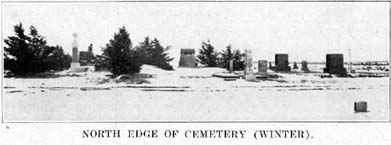
GRANITES AND MARBLES
NEGenWeb Project
Resource Center
Church

GRANITES AND MARBLES
HIS is God's Acre. Here is building the silent city, the place of somber alleys, of weeping willows, cedars and pines. This is the place of flowers, wintergreen, lilies and poppies. This is the place of tears and weeping, of widow's weeds and crape. This is the place of withered wreaths, garlands, broken wheels, anchors and crosses. This is the place of bouquets -- contrite confessions, perhaps of a duty undone in former days, a duty of affection to a loved one that better had been performed before the object of our love has taken abode in these silent chambers. Why did we not hand these flowers to our loved ones, who hungered for a token, before they left us? Why did we wait until we saw the coffin sinking into the grave? Often the flowers are merely for display. They are for the living to view, those who attend the hearse.
In this domain ends all earthly ambition, all toil, all trouble. Hate does not enter here; mortal enemies sleep peaceably side by side. Love finds no response in these dark halls, because love does not here abide. The limpid eye of the hopeful maiden no longer reflects the blue of heaven. Nay, the agate stare in the darkened window of the soul assumes the hue of the ashes to which that window shall return.

|
JUBILEE ALBUM |
165 |
|
166 |
THE FRIDHEM CHURCH |
CORRECTIONS
On Page 45, line 10 from bottom, the name C. J. Lundquist should be C. J. Lunquist, och hustru.In the poem entitled "The Pioneer" the semi-colon after the line "While he adverse highways trod, built a home and broke the sod," should be a comma. (page 97)
On Page 120, line 11, the year 1891 should be 1901
On Page 131, on line 19 from bottom, the date
18791897 should be 1891.Page
151159, the second paragraph (Treasurers), C. G. Gustafson should be C. W. Gustafson.On Page 159, on last line, Andrew Okerson should be Andrew Akerson.
The last paragraph on Page 139 should have the caption "Greetings From Fahlund."
On Page 112, the names under cuts, C. J. Sundquist and Mrs. Sundquist, should be C. J. Lundquist and Mrs. Lundquist.
The name O. J. Bengston, under cut representing Sunday School Superintendent, should be D. J. Bengtson. (photo section)
The name Rueben Swanson under cut "Our Soldier Boys" should read George Swanson. (photo section)
_____
Note: Corrections were made to the corrections by a previous book owner - striking out and adding changes in ink.
 |
 |
 |
 |
|
© 2002 for the NEGenWeb Project by Pam Rietsch, Ted & Carole Miller. |
|||